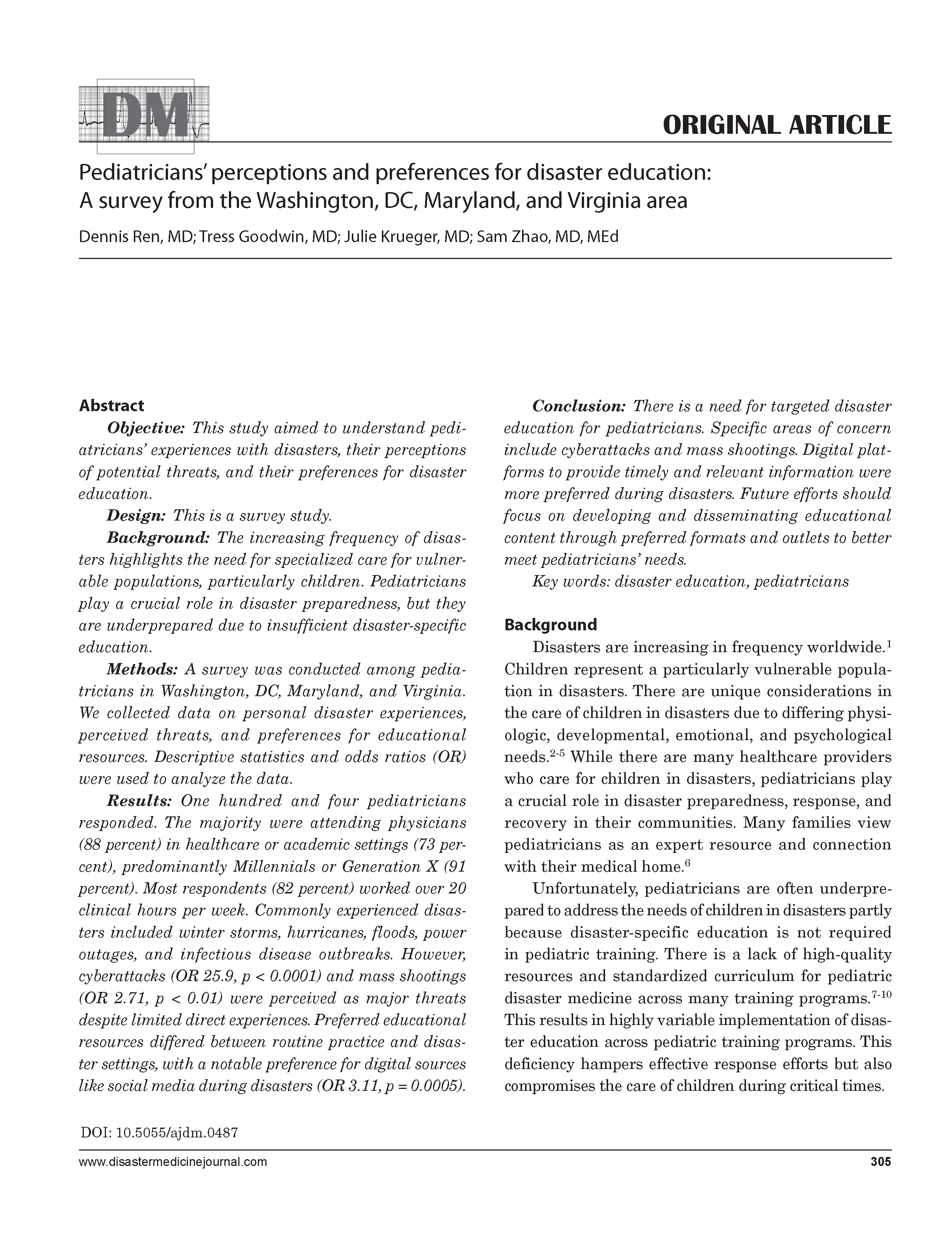Pediatricians’ perceptions and preferences for disaster education: A survey from the Washington, DC, Maryland, and Virginia area
DOI:
https://doi.org/10.5055/ajdm.0487Keywords:
disaster education, pediatriciansAbstract
Objective: This study aimed to understand pediatricians’ experiences with disasters, their perceptions of potential threats, and their preferences for disaster education.
Design: This is a survey study.
Background: The increasing frequency of disasters highlights the need for specialized care for vulnerable populations, particularly children. Pediatricians play a crucial role in disaster preparedness, but they are underprepared due to insufficient disaster-specific education.
Methods: A survey was conducted among pediatricians in Washington, DC, Maryland, and Virginia. We collected data on personal disaster experiences, perceived threats, and preferences for educational resources. Descriptive statistics and odds ratios (OR) were used to analyze the data.
Results: One hundred and four pediatricians responded. The majority were attending physicians (88 percent) in healthcare or academic settings (73 percent), predominantly Millennials or Generation X (91 percent). Most respondents (82 percent) worked over 20 clinical hours per week. Commonly experienced disasters included winter storms, hurricanes, floods, power outages, and infectious disease outbreaks. However, cyberattacks (OR 25.9, p < 0.0001) and mass shootings (OR 2.71, p < 0.01) were perceived as major threats despite limited direct experiences. Preferred educational resources differed between routine practice and disaster settings, with a notable preference for digital sources like social media during disasters (OR 3.11, p = 0.0005).
Conclusion: There is a need for targeted disaster education for pediatricians. Specific areas of concern include cyberattacks and mass shootings. Digital platforms to provide timely and relevant information were more preferred during disasters. Future efforts should focus on developing and disseminating educational content through preferred formats and outlets to better meet pediatricians’ needs.
References
Yzermans J, Donker G, Vasterman P: The impact of disasters: Long term effects on health. In Kirch W (ed.): Public Health in Europe. Berlin Heidelberg: Springer, 2004: 317-341. DOI: 10.1007/978-3-642-18826-8_28. DOI: https://doi.org/10.1007/978-3-642-18826-8_28
Peek L: Children and disasters: Understanding vulnerability, developing capacities, and promoting resilience—An introduction. Child Youth Environ. 2008; 18(1): 1-29. DOI: https://doi.org/10.1353/cye.2008.0052
Lozon MM, Bradin S: Pediatric disaster preparedness. Pediatr Clin North Am. 2018; 65(6): 1205-1220. DOI: 10.1016/j.pcl.2018.07.015. DOI: https://doi.org/10.1016/j.pcl.2018.07.015
Gnauck KA, Nufer KE, LaValley JM, et al.: Do pediatric and adult disaster victims differ? A descriptive analysis of clinical encounters from four natural disaster DMAT deployments. Prehosp Disaster Med. 2007; 22(1): 67-73. DOI: 10.1017/s1049023x00004362. DOI: https://doi.org/10.1017/S1049023X00004362
Gausche-Hill M: Pediatric disaster preparedness: Are we really prepared? J Trauma. 2009; 67(2 Suppl.): S73-S76. DOI: 10.1097/TA.0b013e3181af2fff. DOI: https://doi.org/10.1097/TA.0b013e3181af2fff
Committee on Pediatric Emergency Medicine, Committee on Medical Liability, and the Task Force on Terrorism: The pediatrician and disaster preparedness. Pediatrics. 2006; 117(2): 560-565. DOI: 10.1542/peds.2005-2751. DOI: https://doi.org/10.1542/peds.2005-2751
Koeffler TJ, Demeter NE, Kysh L, et al.: Evaluation and gap analysis of pediatric disaster preparedness resources. Disaster Med Public Health Prep. 2019; 13(2): 330-337. DOI: 10.1017/dmp.2018.23. DOI: https://doi.org/10.1017/dmp.2018.23
Grock A, Aluisio AR, Abram E, et al.: Evaluation of the association between disaster training and confidence in disaster response among graduate medical trainees: A cross-sectional study. Am J Disaster Med. 2017; 12(1): 5-9. DOI: 10.5055/ajdm.2017.0253. DOI: https://doi.org/10.5055/ajdm.2017.0253
Cahan LOS, Hart A, Hertelendy AJ, et al.: Pediatric disaster preparedness curriculum across emergency medicine residencies. Am J Disaster Med. 2024; 19(1): 53-58. DOI: 10.5055/ajdm.0463. DOI: https://doi.org/10.5055/ajdm.0463
Martin SD, Bush AC, Lynch JA: A national survey of terrorism preparedness training among pediatric, family practice, and emergency medicine programs. Pediatrics. 2006; 118(3): e620-e626. DOI: 10.1542/peds.2005-1875. DOI: https://doi.org/10.1542/peds.2005-1875
Revere D, Painter I, Oberle M, et al.: Health-care provider preferences for time-sensitive communications from public health agencies. Public Health Rep. 2014; 129(Suppl. 4): 67-76. DOI: https://doi.org/10.1177/00333549141296S410
Harris PA, Taylor R, Thielke R, et al.: Research electronic data capture (REDCap)—A metadata-driven methodology and workflow process for providing translational research informatics support. J Biomed Inform. 2009; 42(2): 377-381. DOI: 10.1016/j.jbi.2008.08.010. DOI: https://doi.org/10.1016/j.jbi.2008.08.010
Harris PA, Taylor R, Minor BL, et al.: The REDCap consortium: Building an international community of software platform partners. J Biomed Inform. 2019; 95: 103208. DOI: 10.1016/j.jbi.2019.103208. DOI: https://doi.org/10.1016/j.jbi.2019.103208
Schoonjans F: MedCalc’s odds ratio calculator. Available at https://www.medcalc.org/calc/odds_ratio.php. Accessed May 22, 2024.
Brunjes K: Age range by generation. Beresford research. 2019. Available at https://www.beresfordresearch.com/age-range-by-generation/. Accessed April 19, 2024.
Centers for Disease Control and Prevention (CDC): CDC works 24/7. 2024. Available at https://www.cdc.gov/index.htm. Accessed April 18, 2024.
American Medical Association: Available at https://www.amaassn.org/ . Accessed April 18, 2024.
National Institutes of Health (NIH): Turning discovery into health. Available at https://www.nih.gov/. Accessed April 18, 2024.
Search-UpToDate: Available at https://www.uptodate.com/contents/search. Accessed April 18, 2024. DOI: https://doi.org/10.1097/01.EEM.0001027844.53180.5d
US Department of Commerce. National Weather Service: Available at https://www.weather.gov/. Accessed April 18, 2024.
FEMA: Homepage. Available at https://www.fema.gov/home. Accessed April 18, 2024.
AAP: Homepage. Available at https://www.aap.org/. Accessed April 18, 2024.
Goldstick JE, Cunningham RM, Carter PM: Current causes of death in children and adolescents in the United States. N Engl J Med. 2022; 386(20): 1955-1956. DOI: 10.1056/NEJMc2201761. DOI: https://doi.org/10.1056/NEJMc2201761
Abelson R: Fallout from cyberattack at Ascension hospitals persists. Causing delays in patient care. The New York Times. May 23, 2024. Available at https://www.nytimes.com/2024/05/23/health/cyberattack-ascension-hospitals-patient-data.html. Accessed May 23, 2024.
US Department of Health and Human Services: HHS statement regarding the cyberattack on change healthcare. 2024. Available at https://www.hhs.gov/about/news/2024/03/05/hhs-statement-regarding-the-cyberattack-on-change-healthcare.html. Accessed May 23, 2024.
Forbes Advisor: Cybersecurity stats: Facts and figures you should know. Available at https://www.forbes.com/advisor/education/it-and-tech/cybersecurity-statistics/. Accessed May 23, 2024.
Bruce G: Hackers say they sold Lurie children’s hospital data for $3.4M. 2024. Available at https://www.beckershospitalreview.com/cybersecurity/hackers-say-they-sold-lurie-childrens-hospital-datafor-3-4m.html. Accessed May 23, 2024.

Published
How to Cite
Issue
Section
License
Copyright 2007-2025, Weston Medical Publishing, LLC and American Journal of Disaster Medicine. All Rights Reserved.

